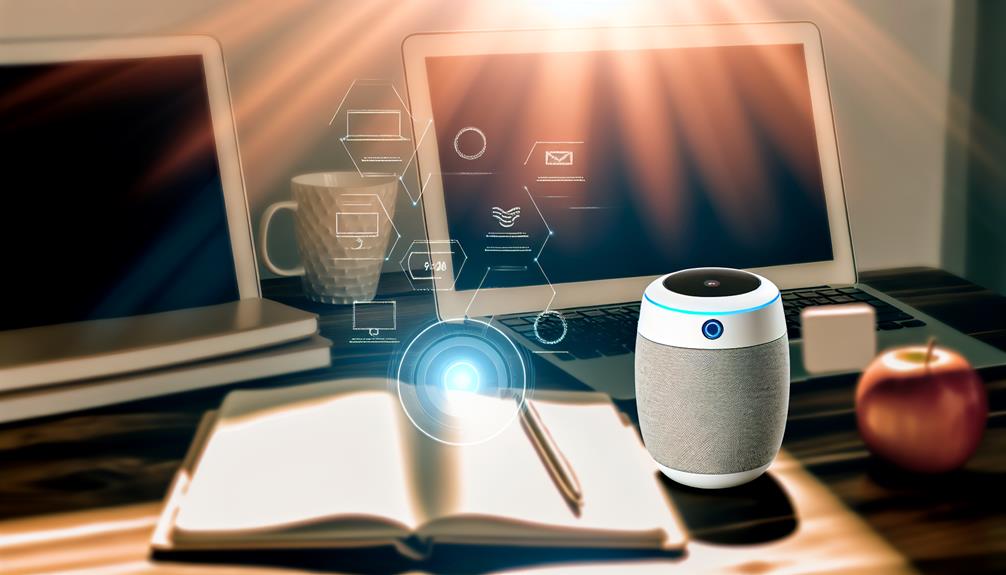What Are the Best AI Personal Productivity Tools?
As the integration of artificial intelligence into our daily routines becomes increasingly prevalent, it raises the question of which AI personal productivity tools truly stand out in enhancing efficiency. Various applications, from virtual assistants to intelligent task managers, offer unique features designed to streamline workflows and optimize time management. However, the effectiveness of these tools can vary considerably based on user needs and preferences. This prompts an examination of the most effective solutions available today, as well as the specific advantages they offer over traditional methods. What might these insights reveal about the future of productivity?
Key takeaways
- Google Assistant: Provides smart reminders and personalized suggestions, enhancing task organization across various platforms and devices.
- Amazon Alexa: Excels in task management, offering timely updates while integrating seamlessly with smart home devices.
- Apple Siri: Known for its user-friendly interface, it efficiently manages tasks and schedules for Apple users.
- Microsoft Cortana: Aids workplace productivity through effective scheduling and email management, streamlining daily tasks.
- Todoist: An intelligent task manager that learns user preferences, enhancing productivity with personalized recommendations.
Overview of AI in Productivity
The integration of artificial intelligence (AI) into productivity tools has ushered in a transformative era, characterized by enhanced efficiency and streamlined workflows. This evolution is redefining the way individuals and organizations approach tasks, fostering an environment where time and resources are utilized more effectively.
As professionals increasingly seek ways to optimize their performance, AI efficiency has become a focal point, enabling users to accomplish more in less time.
AI-driven tools leverage data analysis, machine learning, and automation to identify patterns and suggest improvements, thereby facilitating productivity enhancement. For instance, these tools can automate mundane tasks, allowing users to focus on higher-level strategic initiatives.
Additionally, AI can provide personalized recommendations that adapt to individual work habits, fostering a sense of belonging and ownership over one's productivity journey.
As the landscape of work continues to evolve, embracing AI-powered productivity tools is not merely a trend; it is a necessity for those aiming to thrive in a competitive environment.
Key Features of AI Tools
The effectiveness of AI personal productivity tools largely hinges on their key features, which enhance user experience and streamline workflows.
Automation capabilities allow users to minimize repetitive tasks, while intuitive user interface design guarantees accessibility for a wide range of users.
Additionally, seamless integration with existing applications amplifies the utility of these tools, making them indispensable in today's fast-paced work environment.
Automation Capabilities
While many personal productivity tools boast a range of features, those equipped with robust automation capabilities stand out for their ability to streamline tasks and enhance efficiency.
Automation tools facilitate workflow optimization through process automation, allowing users to eliminate repetitive tasks and focus on high-value activities. By leveraging AI efficiency, these tools can considerably reduce the time spent on data analysis, enabling quicker and more informed decision-making.
Effective task delegation is another hallmark of advanced automation features, allowing teams to assign responsibilities effortlessly and guarantee accountability.
Routine scheduling becomes a breeze with intelligent reminders and predictive scheduling, which anticipate user needs and optimize calendar management. Automated reporting further enhances productivity by providing insights without manual intervention, freeing users from the drudgery of compiling data.
Moreover, decision support capabilities empower users to make strategic choices backed by real-time data analysis, fostering a culture of informed decision-making.
As organizations and individuals increasingly seek to enhance their productivity, the allure of automation capabilities in AI tools becomes undeniable, offering a pathway to a more efficient and organized work life.
User Interface Design
A well-designed user interface (UI) plays a crucial role in the effectiveness of AI personal productivity tools, directly influencing user experience and adoption rates. Adhering to user interface principles is essential for creating intuitive platforms that foster productivity.
Effective visual hierarchy techniques allow users to quickly identify important features, minimizing cognitive load and enhancing user experience optimization.
Design accessibility is another critical aspect; ensuring that tools are usable for individuals with varying abilities promotes inclusivity and belonging.
Responsive design strategies also enhance user engagement by adapting to different devices, offering seamless interaction across platforms.
Incorporating interaction design elements, such as easily navigable menus and clear call-to-action buttons, is essential for guiding users through their tasks.
In addition, user feedback integration and usability testing methods are imperative for refining interfaces, ensuring that users' needs are met and pain points addressed.
Integration With Apps
Integration with various applications is a vital feature that enhances the functionality of AI personal productivity tools. By ensuring robust app compatibility, these tools enable seamless connections across diverse platforms, fostering collaboration and efficiency. Data synchronization is essential, allowing users to access their information in real-time, regardless of the application in use.
AI tools often leverage third-party integrations to expand their capabilities, promoting tool interoperability and enhancing overall user experience. This is particularly beneficial for professionals who rely on cloud-based solutions, as they can seamlessly integrate their productivity tools with existing workflows.
However, integration challenges can arise, particularly concerning user permissions and security measures. It's essential that organizations prioritize security while implementing these integrations to protect sensitive data.
The following table summarizes some key features of AI tools related to app integration:
| Feature | Description | Benefits |
|---|---|---|
| App Compatibility | Ability to connect with various software | Enhances usability |
| Cross-Platform Functionality | Works across different operating systems | Increases accessibility |
| Data Synchronization | Real-time data updates across apps | Improves productivity |
Top AI Personal Assistant Apps
Numerous AI personal assistant apps have emerged as indispensable tools for enhancing productivity in both personal and professional spheres. These applications leverage advanced algorithms and voice assistant functionalities to streamline tasks and improve efficiency.
By offering personalized recommendations, they cater to individual user needs, ensuring that productivity is maximized.
Here's a selection of top AI personal assistant apps that have gained traction for their impressive features:
- Google Assistant: Integrates seamlessly with various services, offering smart reminders and personalized suggestions.
- Amazon Alexa: Beyond smart home control, it excels in organizing tasks and providing timely updates.
- Apple Siri: Known for its user-friendly interface, it delivers personalized recommendations and efficient task management.
- Microsoft Cortana: Focuses on productivity in the workplace, aiding in scheduling and email management.
- Todoist: An intelligent task manager that learns user preferences over time, enhancing its suggestions.
These AI personal assistant apps not only save time but also create a sense of connection by understanding user habits.
As they evolve, they promise to foster a more organized, efficient lifestyle, allowing individuals to focus on what truly matters.
Smart Calendar Solutions
Leveraging intelligent algorithms, smart calendar solutions have revolutionized the way individuals manage their time and schedules. These advanced tools go beyond traditional calendar functionalities by integrating smart scheduling features that optimize meeting arrangements and personal commitments. By analyzing user preferences, work patterns, and even geographical locations, they facilitate seamless coordination, ensuring that time is utilized in the most effective manner.
Moreover, smart calendar solutions offer personalized reminders that align with individual goals and priorities. These reminders can be customized based on specific tasks, deadlines, or even personal well-being prompts, such as taking breaks or engaging in mindfulness activities. As a result, users not only stay organized but also foster a healthier work-life balance.
The sense of belonging comes from the enhanced connectivity these tools provide, allowing for effortless collaboration with colleagues and loved ones. As users share their calendars, they can coordinate plans more efficiently, reducing the friction often associated with scheduling conflicts.
In a world where time is a precious commodity, adopting smart calendar solutions can lead to improved productivity, fostering a culture of efficiency and collaboration that benefits both individuals and teams alike.
Task Management Innovations
In the domain of personal productivity, task management innovations have emerged as pivotal tools that enhance efficiency and organization.
These advancements allow individuals and teams to streamline their workflows, guaranteeing that tasks are not only completed but also aligned with overarching goals.
Key features of modern task management tools include:
- Task Delegation: Assign responsibilities clearly to optimize team collaboration.
- Priority Setting: Identify urgent tasks to focus on what matters most.
- Goal Tracking: Monitor progress towards objectives to maintain motivation and direction.
- Deadline Reminders: Guarantee timely completion of tasks to avoid last-minute stress.
- Project Visualization: Utilize graphical representations to better understand project timelines and dependencies.
AI-Powered Time Tracking
AI-powered time tracking tools offer significant benefits, including enhanced productivity insights and efficient task management.
By automating the process of logging hours and analyzing work patterns, these tools not only save time but also integrate seamlessly with existing workflows.
As we explore the top AI solutions available, it becomes evident how these innovations can transform the way professionals manage their time.
Benefits of Time Tracking
Tracking time effectively can greatly enhance personal productivity, particularly when supported by advanced AI technologies. By implementing AI-powered time tracking tools, individuals can leverage data-driven insights to optimize their workflows and achieve significant time management benefits.
The advantages of AI-enabled time tracking are manifold:
- Increased Awareness: Understand where time is spent, highlighting inefficiencies.
- Data-Driven Decisions: Use analytics to make informed choices about task prioritization.
- Enhanced Accountability: Foster a culture of responsibility by tracking progress transparently.
- Reduced Procrastination: Identify patterns of distraction and address them proactively.
- Improved Work-Life Balance: Allocate time more effectively, ensuring personal commitments are honored.
Top AI Tools
Leveraging advanced technology, several AI tools have emerged that revolutionize the way individuals manage their time. These tools enhance productivity by utilizing machine learning algorithms to analyze work patterns, allowing users to optimize their schedules effectively. As remote work becomes increasingly common, the need for efficient time tracking solutions that respect AI ethics, user privacy, and data security is crucial.
The following table outlines some of the top AI-powered time tracking tools available today:
| Tool Name | Key Features | User Customization |
|---|---|---|
| Time Doctor | Productivity metrics, reports | Customizable alerts |
| Harvest | Task prioritization, invoicing | Integration with apps |
| RescueTime | Cognitive load analysis | Personalized goals |
These tools not only assist with task prioritization but also contribute to digital wellbeing by minimizing cognitive load. Users can benefit from tailored insights that promote healthy work habits, improving overall efficiency and satisfaction. The focus on user customization guarantees that individuals can adapt these tools to their unique workflows, fostering a sense of belonging in a collaborative environment.
Integration With Workflows
Integrating time tracking tools into existing workflows can greatly enhance productivity and streamline processes. By adopting AI-powered time tracking solutions, organizations can implement effective workflow optimization strategies that not only promote accountability but also foster a culture of efficiency.
These tools provide insights into how time is spent, allowing teams to identify areas for improvement and adjust their practices accordingly.
Key benefits of AI-powered time tracking include:
- Automated time logging: Eliminates manual entry, reducing errors and saving time.
- Real-time analytics: Offers immediate feedback on productivity, helping teams make informed decisions.
- Seamless tool integration: Connects effortlessly with other project management and communication tools.
- Customizable reporting: Allows for tailored insights that align with specific team goals.
- Enhanced collaboration: Promotes transparency and teamwork by sharing time usage data across departments.
Automation for Email Management
In today's fast-paced digital landscape, effective email management is crucial for maintaining productivity and focus. Automation tools specifically designed for email can drastically transform how individuals handle their messages, guaranteeing that important communications are prioritized while minimizing distractions.
Email filtering enables users to categorize incoming messages based on custom rules, allowing for seamless inbox organization. Coupled with priority categorization, this feature guarantees that essential emails are never overlooked. Additionally, spam detection technology guards against unwanted solicitations, freeing up mental bandwidth for more pressing tasks.
Automation also streamlines responses through intelligent response suggestions, helping users reply promptly without drafting every message from scratch. Follow-up reminders guarantee that no important correspondence falls through the cracks, while scheduling automation allows users to plan when emails are sent, optimizing communication flow.
Moreover, attachment management simplifies the process of organizing files linked to emails. Unsubscribe tools help declutter inboxes by allowing users to easily remove themselves from unwanted mailing lists. Finally, email analytics provide insights into communication patterns, enhancing overall efficiency.
Enhanced Focus and Mindfulness Tools
Maintaining focus in an age of constant distractions can be a formidable challenge, prompting many to seek out enhanced focus and mindfulness tools.
These tools are designed to foster mental clarity, cultivate productivity rituals, and support attention training, enabling users to achieve greater cognitive enhancement and stress management.
To effectively harness these benefits, consider integrating the following:
- Mindfulness Exercises: Engage in short practices that promote awareness and presence.
- Meditation Apps: Utilize technology to access guided sessions for deeper relaxation.
- Focus Techniques: Implement strategies like the Pomodoro Technique to structure work intervals.
- Distraction Reduction Tools: Use applications that block distracting websites and notifications.
- Digital Detox: Regularly disconnect from digital devices to reset your mental state.
Collaboration Tools With AI
As remote work becomes increasingly prevalent, collaboration tools enhanced by artificial intelligence are transforming how teams communicate and manage tasks.
These tools facilitate enhanced team communication, enable smart task management, and streamline workflow automation, ultimately fostering greater productivity.
Enhanced Team Communication
Effective team communication is vital for fostering collaboration and enhancing overall productivity, and AI-powered tools are revolutionizing this aspect of work. By addressing common communication barriers, these technologies facilitate improved team dynamics and support remote engagement, enabling teams to thrive in virtual environments.
Key features of AI-powered collaboration tools include:
- Message Prioritization: Guarantees important communications are highlighted for swift attention.
- Feedback Loops: Streamlines the process of gathering and providing constructive feedback.
- Brainstorming Tools: Enhances creative collaboration, allowing for diverse ideas to surface efficiently.
- Conflict Resolution Aids: Identifies potential conflicts early, facilitating timely intervention.
- Decision Making Aids: Leverages data-driven insights to inform team decisions.
These tools not only promote effective virtual collaboration but also consider cultural nuances that may affect communication styles.
Smart Task Management
Smart task management is a crucial element in maximizing productivity, particularly in collaborative environments. As teams increasingly rely on AI-driven tools, the integration of task prioritization strategies becomes essential for maintaining focus and efficiency. These strategies help team members identify urgent and important tasks, ensuring that collective efforts align with overarching goals.
AI-enhanced collaboration tools offer robust project visualization techniques, allowing teams to see the bigger picture while managing individual contributions. For instance, visual dashboards can represent project timelines, milestones, and task interdependencies, fostering a sense of shared purpose. This visual clarity not only boosts motivation but also mitigates the risk of task overlap or miscommunication among team members.
Moreover, leveraging these tools can streamline decision-making processes, as they provide real-time insights and analytics that keep everyone informed. The ability to quickly adjust priorities based on collective input enhances adaptability, making teams more resilient in the face of challenges.
Streamlined Workflow Automation
In today's fast-paced work environment, streamlined workflow automation has become essential for enhancing team collaboration and productivity.
By leveraging AI-driven collaboration tools, organizations can optimize their processes, ensuring that every team member is aligned and engaged. These tools not only facilitate communication but also integrate task prioritization strategies and productivity measurement techniques into daily operations.
Key benefits of AI-powered collaboration tools include:
- Improved Communication: Real-time updates and notifications keep everyone on the same page.
- Enhanced Task Management: Automate the assignment of tasks based on priority and deadlines.
- Data-Driven Insights: Use analytics to measure productivity and identify bottlenecks.
- Seamless Integration: Connect with existing systems to streamline workflows effortlessly.
- Team Accountability: Establish clear ownership of tasks and deadlines.
Future Trends in AI Productivity
Anticipating the future of AI productivity tools reveals a landscape rich with innovation and transformative potential. As AI advancements continue to evolve, they will address pervasive productivity challenges, particularly in the context of remote work and digital transformation. Machine learning algorithms will enhance user experience, making tools increasingly intuitive and customizable, thereby improving user adaptability.
However, as these tools proliferate, ethical considerations around data privacy must remain at the forefront. Organizations will need to balance the drive for workplace efficiency with the responsibility of protecting sensitive information. As users become more aware of these issues, their expectations for transparency and ethical practices will rise.
The following table highlights key trends shaping the future of AI productivity:
| Trend | Impact on Productivity | Considerations |
|---|---|---|
| AI Personal Assistants | Enhanced task management | User adaptability |
| Predictive Analytics | Informed decision-making | Data privacy |
| Collaborative Tools | Improved team synergy | Ethical considerations |
Frequently Asked Questions
How Do I Choose the Right AI Productivity Tool for My Needs?
To select an appropriate AI productivity tool, assess user preferences regarding functionality, interface, and integration capabilities. Prioritize solutions offering effective task automation that aligns with your workflow, ensuring enhanced efficiency and satisfaction in your daily tasks.
Are AI Productivity Tools Compatible With Existing Software I Use?
Many users encounter integration challenges when incorporating AI productivity tools with existing software. For instance, a marketing team successfully integrated an AI tool with their CRM, enhancing efficiency, yet faced initial software compatibility issues that required resolution.
Can AI Tools Help With Work-Life Balance?
AI tools enhance work-life balance by facilitating AI time management and automated scheduling, allowing individuals to allocate time effectively between personal and professional responsibilities, ultimately fostering a healthier integration of both aspects in daily life.
What Are the Privacy Implications of Using AI Productivity Tools?
Steering through the labyrinth of AI productivity tools, users must prioritize data security and guarantee informed user consent. Each choice shapes the landscape of privacy, underscoring the importance of vigilance in safeguarding personal information amidst technological advancements.
How Much Do AI Personal Productivity Tools Typically Cost?
AI personal productivity tools typically employ subscription models, with costs ranging from $5 to $30 per month. Analyzing their cost effectiveness reveals that users often experience enhanced efficiency, making them a valuable investment for productivity enhancement.



